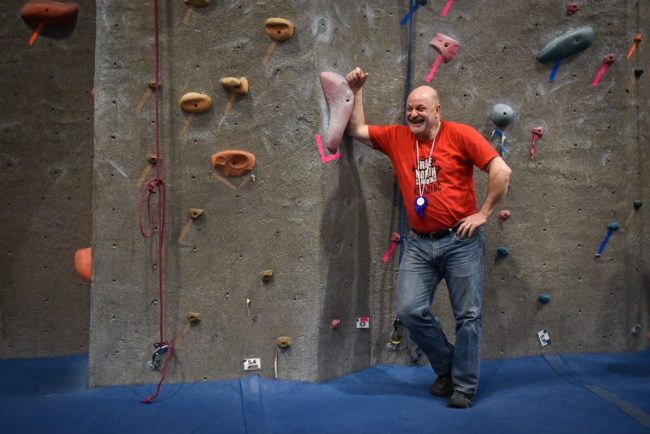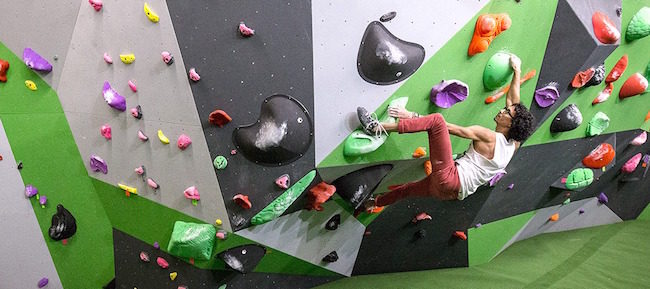Reimbursement Denied To Twin Falls Gym

An Early Raise For Canadian Workers

Next Level Pop-up Store
Advanced materials company Cocona Inc took their marketing to new levels with a one-day pop-up store in Eldorado Canyon.
The shop was open on Bastille Wall in Eldorado Canyon, Colorado not far from where Cocona is headquartered. The company gave out apparel from Adidas, Rab, and Point6, all made with their patented technology.
Dave Bywater, 11-year climbing ranger in Grand Teton National Park and Cocona employee, manned the shop from sunrise to sunset outfitting climbers.
In addition to increasing their brand awareness, Cocona raised awareness and support of their ongoing mission to provide access to public lands for climbing, donating $5,000 each to the Access Fund, the American Alpine Club, and the Action Committee for Eldorado (ACE) to replace aging anchors.
The Shifting UK Gym Scene

Challenges
Dean Straw, Marketing and Advertising Manager with Mile End Climbing Wall (MECW) in London, has been with the company for fourteen years. MECW is believed to be the oldest customer-facing, dedicated indoor climbing facility in the country. As pressures on marketing intensified, Straw’s role has developed organically into its current shape. “When we started out, there was no need to market ourselves. The last eight to ten years brought a dramatic shift and it definitely takes more time and money to promote MECW today. Prices in traditional media advertising are prohibitive, so we now focus on social media and the website. The most important marketing tool remains the same: face-to-face contact with the customer,” explains Straw. MECW’s operational model as a charity is unique but doesn’t mean it’s not in direct competition with London’s established venues or recent arrivals. This year alone, two new climbing walls are due to open in close proximity to Mile End. “If the development continues, climbing walls unable to keep up with current market trends and evolving customer needs will be forced to close down. If you are located in a saturated area, without good marketing you will go under,” warns Straw. Located a few miles from the town of Royal Tunbridge Wells, Evolution Climbing was forced to close down earlier this year. A few months prior, a more modern facility (Chimera Climbing) had opened in town centre. “At Evolution, they simply stagnated. Didn’t promote themselves, didn’t try to keep up,” commented an anonymous climbing industry professional. While some struggle to stay afloat, others with more funds at their disposal face their own challenges in trying to expand their businesses. Highly urbanised areas offer access to a wide audience but finding suitable properties remains an ongoing issue. “The biggest problem in central London is short-term leases. Five years isn’t enough for a climbing wall,” says Rob Mitchell from Craggy Island who operates two centres on the outskirts of the capital. His opinion is shared by Fred Stone, director at The Arch Climbing Wall. Stone says that finding the right property is the biggest hurdle to opening a new site. At present, The Arch operates three venues in central London but new branches are planned for 2019. “I don’t want to disclose the locations yet but as soon as the contracts are finalised, we will definitely let people know. I’m the most excited for our custom built facility which will be the first in the country,” added Stone.Opportunities
For marketing savvy climbing centres, the future seems bright. “Successful walls realise there’s a massive potential and they’re buying additional branches. It seems that you can just look at the map, see where there’s no customer-facing climbing facilities and, with a little bit of investment, you can have a successful business straight away,” said a source who also wished to remain anonymous. The same used to be true for older climbing walls such as Craggy Island and Manchester Climbing (now at four locations in and out of Manchester). “When we started out, Manchester didn’t have any satisfactory climbing facility. We simply took advantage of a gap in provision,” says Mike Lloyd. Craggy enjoyed a similar situation with no competition within a 50-mile radius unless you wanted to brave a trip to central London. Now both companies find themselves competing with facilities recently established in close proximity. In turn, new centres springing up in currently underserved areas are likely to face the same challenges in the near future. To gain a competitive edge, many companies have adopted a business model of aggressive expansion through adding new sites. Among those are Arch Climbing Wall, The Climbing Hangar and Beacon Climbing. Tommy Chammings, from Beacon points to the operational advantages of running multiple centres: “In many aspects, you can simply multiply your work. Independent walls will always struggle to afford dedicated, professional marketing.” Asked if independent walls can’t withstand competition with growing chains, Dean Straw answered with a question: “Did all independent coffee shops close after we got Starbucks? It seems that UK indoor climbing businesses have two choices: go big and become a chain, or stay small and carve a niche of cult following and a faithful customer-base.” Vivien Underwood, Communication and Events Manager at the Climbing Hangar believes that “there’s room for both small, specialised climbing walls catering for the needs of a particular crowd and for more open, general public-minded places. But like with any sport that hits the mainstream, there’s gonna come a point when someone really big wants to start buying climbing walls.” To withstand the competition, indoor climbing businesses need to be ready to stand their ground by creating strong brand identities.Identity
Unique facilities are often an important differentiating point, with The Castle Climbing Centre in London being a prime example. In 1995, the company took over a former Victorian pumping station with its distinctive, castle-like looks and a huge surface area. “Our facility is so unique that it’s sometimes difficult to communicate it before it’s actually experienced in flesh. We’re a destination centre,” says Amy Yates, who recently took over the position of Communication and Events Manager. Like many other successful walls, the Castle has an extensive development plan but in this case, it revolves solely around expanding the existing site. The centre is packed on every weekday evening and “every time a new climbing wall opens in the London area, we end up experiencing a surge in visits,” adds Yates. For many of the country’s original climbing walls (such as the Castle, MECW, or the legendary Climbing Works in Sheffield), brand identities have evolved organically and have a recognisable presence within the community. At the same time, reaching out to new clients requires more commercially-orientated efforts. Mile End Climbing Wall refreshed their visual identity five years ago, while Beacon Climbing has recently developed a separate brand to use at their new branches. “Our original centre in Wales is located in one of the country’s most important regions for outdoor climbing. As a training facility for dedicated climbers, we offer a high quality product that markets itself. The brand is spread by word of mouth among the close-knit community. It’s synonymous with North Wales, so we felt that it wasn’t relevant for our new locations. Under the new brand, Big Rock, we already operate one gym in Milton Keynes and another one is due to open in October. A third venue in Peterborough is in its early development,” says Tommy Chammings.Close to the core
Asked about target audiences, multi-centre companies with aggressive expansion plans talk mostly of “building a community”, while smaller, independent walls point to the necessity of reaching out to the general public, even at the cost of retention. At the same time, most describe their customer base as split fifty-fifty between “climbers” and “non-climbers”. Popular A-listers, like Europe’s biggest climbing arena, EICA Ratho in Edinburgh, or Westway Climbing in London, operate with the support of local authorities. Their strong brands are directly tied with their unparalleled facilities and sheer size (Ratho) or excellent location (Westway). “We’re directly under a motorway and in the evening we’re a stopover point for scores of commuters,” explains Jez Tapping, Head of Climbing at Westway. Both Ratho and Westway operate in liaison with larger leisure centres of which they are part. As a result, both function on a very different plane to most climbing centres in the country. “It’s practically impossible for a privately owned climbing wall to be in direct competition with us,” points out Tapping. However, despite being a part of mainstream leisure centres, both Westway and Ratho wish to uphold identities closely connected to the core climbing community. While fitness-orientated commuters take over Westway in the evenings, the centre fills up with outdoor rock climbers during the day. “That’s how we started out and we want to retain our appeal to core climbers,” says Tapping. Ratho ensures their connection with the outdoor community through a relation with renowned Scottish big-wall and alpine climber, Robbie Phillips, who acts as a routesetter and an ambassador. While no existing or new gyms want to risk cutting their ties with the well established, traditional core climbing community, most agree on the importance of growing the market. Reaching out to new audiences is reportedly much easier in highly urbanised areas, where climbing walls have the luxury of choosing their audience. “It’s really easy to have loads of kids’ parties or loads of families coming during school holidays and never coming back,” said Vivien Underwood from The Climbing Hangar. With its original location in Liverpool, a new take-over branch in London, and the third facility on its way, the Hangar builds its marketing efforts around “putting people in touch with each other and building new connections through the shared love of climbing. We’re mostly interested in building a community of people who want to contribute and come back. The real challenge is retention and our marketing strategy is evolving to reflect that.”Professionalisation
The necessity to ground marketing in an appealing brand complete with a compelling visual identity is recognised by most existing climbing centres, but according to branding professional Kieran Riddiough, “for most of them it seems almost like an afterthought.” With no climbing background, Riddiough was invited to develop an identity for Yonder, a new centre soon to open its doors in East London. Riddiough and the centre’s founders went through a huge list of names before they settled for Yonder. Then followed a process of designing a logo that would be suitable for every aspect of their project. Reflecting climbing’s entry into the mainstream, Yonder will be a bouldering facility integrated with a community centre, boasting a co-working space, yoga studio, exhibition venue, bar and cafe. Yonder’s brand guidelines are so precise that custom coloured climbing holds had to be ordered. “If somebody visits us and takes a picture for their social media, we want the venue to be immediately recognisable,” explains Riddiough. It takes only a quick look at the jobs section of UKC, Britain’s most popular climbing website, to notice that climbing centres old and new seek to include branding and marketing professionals, as well as content creators, within their teams. Manchester Climbing Centre is among those looking to employ a full-time campaigns coordinator. At the Climbing Hangar, Vivien Underwood was recently brought in-house after a few years of part-time freelancing. Rob Mitchell is seeking to outsource social media management with an online marketing agency, and Dean Straw regularly shores up his marketing activities with the help of an external consultancy. “We will soon see an influx of specialised, experienced professionals into the climbing industry. Most skills are transferable. It’s no longer essential for higher management to be climbers,” says Straw, a thought that’s echoed by Mike Lloyd: “Climbing attracts creative people. At the moment marketing standards massively vary but they certainly will get pushed up.” Beyond propelling individual businesses, vigorous marketing is the only way to expand the indoor climbing market in the interest of the whole sector. For now, the UK has seen no industry-wide initiatives at growing the market but Rob Mitchell from Craggy Island hopes it will change. “We need something that will promote climbing to the general public on a larger scale. For now, we all are too preoccupied with our own businesses but if we want the whole sector to thrive, at some point we will have to come together.”Why Corporate Formation Matters
 By Derek Larsen-Chaney and Jason Pill
Because most gyms trace their business roots back to humble beginnings as a small start-up company rather than a federally-regulated, large corporate entity, it’s not uncommon for gyms to overlook basic corporate formation issues.
Gym owners typically race to form a corporate entity to protect themselves from corporate debts and other liabilities and then focus on more exciting pursuits such as collecting capital, designing their walls, and picking out holds. However, choosing a corporate formation structure, whether it be a corporation (“S Corp” or “C Corp”), partnership, limited liability company (“LLC”), or other vehicle, is a critical decision at the beginning of any climbing gym’s business life that impacts how the gym will be governed, managed, owned, and possibly acquired.
As summed up by Hal Thureson, co-owner of Vertical Ventures of Tampa and St. Petersburg, Florida: “It’s easy to focus on what’s in front of you and the immediate concerns when you’re starting up a gym. As a result, it’s even easier to overlook the tax and legal ramifications of your initial decisions when you start the business. However, if you plan on being around for the long run, these decisions are critical to the success and longevity of your gym.”
For all of those reasons, and a few more explained below, corporate formation is a key issue for both new and established gyms.
By Derek Larsen-Chaney and Jason Pill
Because most gyms trace their business roots back to humble beginnings as a small start-up company rather than a federally-regulated, large corporate entity, it’s not uncommon for gyms to overlook basic corporate formation issues.
Gym owners typically race to form a corporate entity to protect themselves from corporate debts and other liabilities and then focus on more exciting pursuits such as collecting capital, designing their walls, and picking out holds. However, choosing a corporate formation structure, whether it be a corporation (“S Corp” or “C Corp”), partnership, limited liability company (“LLC”), or other vehicle, is a critical decision at the beginning of any climbing gym’s business life that impacts how the gym will be governed, managed, owned, and possibly acquired.
As summed up by Hal Thureson, co-owner of Vertical Ventures of Tampa and St. Petersburg, Florida: “It’s easy to focus on what’s in front of you and the immediate concerns when you’re starting up a gym. As a result, it’s even easier to overlook the tax and legal ramifications of your initial decisions when you start the business. However, if you plan on being around for the long run, these decisions are critical to the success and longevity of your gym.”
For all of those reasons, and a few more explained below, corporate formation is a key issue for both new and established gyms.
Title
These important decisions regarding corporate structure also impact the ways in which gyms can be acquired or expand in the event they aspire to have more than one location. As a result, this article is the first of two articles to address corporate formation and expansion. This article sets the table by discussing the basics of corporate formation (and why they matter), and the second article will discuss options for gyms to consider when expanding, or planning to expand, to additional locations. For purposes of this article, we’ll address the two basic—and most common—corporate structures: LLCs and corporations.Protecting Yourself From Debts: The Primary Benefit
One of the hallmarks of forming an LLC or corporation is the creation of a new legal entity. Under long-standing legal notions, business entities are treated separately from their associated owners, in what is often referred to as “corporate personhood.” The law bestows upon the business entity certain legal rights and responsibilities, including the right to enter into contracts with other parties, to sue or be sued in court the same way a natural person would, and to have and maintain debts. As a result of this corporate personhood, corporation shareholders and LLC members are not personally liable for the debts of the company (as long as there are multiple legitimate members, the company is adequately capitalized, and the company is not a mere shell setup solely to protect members). With the exception of “shell” or “dummy” entities, individual owners and members will be shielded from the debts of the business, which allows for much greater entrepreneurism. Although this benefit is common to both corporations and LLCs, each structure has unique pros and cons to consider when selecting the proper business entity for formation purposes.Benefits of Limited Liability Companies
The word used most often when discussing the virtues of LLCs is “flexibility.” The LLC, which is a creature of statute, allows remarkable flexibility in structure, management, profit distribution, and taxation. As such, an LLC is often the entity of choice for smaller businesses with few stakeholders. LLCs can elect to be taxed as a sole proprietor, partnership, or corporation (as long as it would otherwise qualify for such tax treatment). Under the default provisions provided by most state statutes, LLCs are not subject to the “double taxation” of a C Corp (we’ll explain the difference between S Corps and C Corps below, along with the differences in taxation between the entities). Generally, the LLC is “disregarded” for tax purposes and profits are taxed only at the member level. Moreover, an LLC with multiple members that elects to be taxed as a partnership may specially allocate the members’ distributive share of income, gain, loss, deduction, or credit via the company operating agreement on a basis other than the ownership percentage of each member, provided that certain federal rules are met. Additionally, as a practical matter, the formal administrative requirements for an LLC are far less onerous than for a corporation. This allows for more efficient management with less paperwork and fewer required meetings. Because LLCs are creatures of statute, and most statutes have detailed statutory schemes to govern LLCs, the statutes are “default” laws, which means that generally speaking, absent a provision to the contrary in the governing documents of the LLC (i.e., the articles of organization or the operating agreement), the statutes will govern the business and affairs of the LLC and the relationships among the managers, members, and LLC. Outside of a few mandatory statutory provisions, the members will have the ability to draft an operating agreement to provide the restrictions and arrangements they desire, thus providing a great deal of flexibility to the LLC. Benefits of a Corporation For-profit corporations can form under IRS subchapter S or subchapter C (“S Corps” and “C Corps”). With both of these structures, the primary benefit (in addition to limiting personal liability) is predictability and formality. The corporate structure—whether it be a C Corp or S Corp—is well accepted and understood by financial advisors, lenders, lawyers, and, perhaps most importantly, investors. The recognized ownership and voting structure of corporations may be very appealing to investors who seek the certainty of established corporate laws and governances. Although an LLC may provide great customization, not every investor may want to deal with the nuances and quirks of your gym’s particular LLC, and may prefer the formalities and familiarities of a corporation.C Corps vs. S Corps
C Corps offer greater flexibility than S Corps with respect to ownership structure. For example, a C Corp can issue multiple classes of stock, each providing different voting and dividend rights. Additionally, there is no limit to the number of stockholders in a C Corp. Some of these issues may seem too ambitious for starting gym owners looking to quickly protect themselves from liability, but these considerations may impact longer term growth and expansion options of the business, especially if it will seek outside investment. S Corps, on the other hand, have limited membership and are restricted to no more than 100 shareholders, and can only have one class of stock (disregarding voting rights). Also, unlike C Corps, S Corps cannot have non-US citizens and residents as shareholders. Moreover, S Corps cannot be owned by C Corps, LLCs, partnerships, or other S Corps.Taxation Issues
There are several factors that may make a corporation attractive when it comes to the corporation versus LLC decision. Many of these factors relate to the taxation of the company, including deductions for the costs of providing health insurance to employees and shareholders. As mentioned above, an LLC has complete flexibility, which includes flexibility on how it wants to be taxed. A C Corp, however, does not have such flexibility. A major disadvantage to the corporate designation is its double taxation implications. The corporation’s profits are taxed once at the corporate level (corporate tax), and any dividends to the corporation’s shareholders are taxed again at the individual level (individual tax). Alternatively, an S Corp allows for pass-through taxation (no corporate tax), similar to an LLC. Unlike an LLC, an S Corp’s dividends are not subject to an employment tax, whereas an LLC’s are. As noted above, there are certain requirements to qualify as an S Corp that may limit its utility to a gym, especially a larger gym looking to expand. Depending upon the circumstances of the gym, it may have no choice but to be a C Corp and face double taxation. An LLC, on the other hand, can elect how it wants to be taxed. By default, an LLC is treated as a “pass-through” entity (meaning single taxation), but, if it qualifies, an LLC may elect to be taxed as a S Corp or an C Corp. While it may seem counter-intuitive for a start-up business to volunteer to be taxed twice, there are some circumstances in which this situation may be beneficial, but you’ll need to confirm with an accountant. For most LLCs, double taxation will not be beneficial and the members will not select this option. Again, though, the beauty of the LLC is its flexibility. All of this talk of taxation demonstrates the various financial implications associated with corporate formation, and these issues will vary for each gym. For those reasons, you should always consult a proper tax professional or accountant to make sure your gym is set up in the most tax-advantageous structure.Employment Law Issues
Many climbing gyms assume (or hope) that state and federal employment laws do not apply to them because they are too small. And while there is some truth to that, it is a risky and complicated assessment that will depend on corporate formation. For reference, many federal laws, including Title VII—the federal anti-discrimination statute—require a gym to have more than 15 employees to be covered. Similarly, the Family Medical Leave Act requires a gym to have at least 50 employees before periods of up to 12-weeks’ leave can become required for qualifying employees. As such, it becomes critical to know when and how these laws apply (for more background, refer to the prior CBJ article “Spotting Employment Discrimination“). Because the first step to determining coverage under most employment laws requires a simple count of employees, it is critical to know the precise number of employees to include and which individuals, such as owners or LLC members, to exclude. Frequently, under most state and federal laws, owners are not included in the count of employees when determining coverage. For example, if your gym has 14 employees and 2 owners, the gym likely would not be covered by Title VII (triggered at 15 employees), meaning that an employee could not bring a lawsuit under Title VII against the gym. This determination, though, is very fact-intensive and depends on the structure of the entity and its actual operations. Thus, the corporate formation and corresponding designation of owners may impact whether a gym is subject to and must comply with various employment laws. Another question arises when a gym owns multiple locations, each registered and established as a separate corporate entity, with multiple employees at each location. Are all of these employees counted when determining whether the gym is subject to various state and federal laws, even though the employees technically work for different companies, e.g., Climbing Gym 1, Inc., Climbing Gym 2, Inc., and Climbing Gym 3, Inc.? Once again, it depends. Generally, courts apply an “integrated enterprise” test to determine whether all the employees of various companies are operating under a “single enterprise” or employer. The test for establishing whether the multiple companies are operating jointly varies by jurisdiction, but the factors typically considered include: (1) the interrelation of the operations; (2) the presence of common management; (3) centralized control of human resources or workforce management; and (4) common ownership or financial control. Put simply, courts and federal enforcement agencies, like the Equal Employment Opportunity Commission (the “EEOC”), will look past the veneer of corporate formalities to determine whether multiple companies are operating as a single enterprises with a common management structure. This means that a gym system that has created separate companies for each of its locations may still be subject to certain state and federal employment laws because the number of employees at each location can be aggregated to determine if coverage exists under these laws. This issue is of critical importance because it determines whether gyms are subject to, and can be sued under, various employment laws. For larger gym systems looking to expand and operate multiple locations, whether they are under the same parent company or not, these formation issues may have a significant impact on a gym’s coverage under state and federal employment laws. This is yet another consideration that must be discussed at the corporate formation level, and certainly when evaluating expansion of a gym.So What’s the Best Entity for My Gym?
In sum, there are advantages and disadvantages associated with each entity discussed. Each offers the individual owners of a gym protection from the liabilities of the company. The flexible and less formal LLC rules also allow for more efficient management, especially in the earlier stages of a gym’s development. Corporations, especially C Corps, are by design easier to expand as the gym grows, and incorporating additional investors is a more straightforward process. Of course, there are starkly different tax treatments that will impact the gym’s finances and ability to expand. Lastly, there are various employment laws that get triggered based on the size of a gym’s workforce, which are affected directly by management structure and corporate organization. These decisions will have a lasting impact on your gym, and require attention as your gym grows and expands. As explained by Thureson when looking back on the beginnings of Vertical Ventures, “it’s easy to say that we should have given some corporate decisions more focus.” Elaborating on that point, Thureson further explained that, “after owning the business for more than a decade, we’ve had to make adjustments to our corporate and tax structure along the way. . . . if we had the right relationships in place for legal and tax advice at the outset, we could have handled those issues earlier, as opposed to switching certain things midstream, and avoided some headaches.” So, there’s no one-size-fits-all answer when choosing between LLC, S Corp, and C Corp, but there are a lot of possibilities to consider based on where your gym is and where you want it to go. It is important to note that while the initial determination of which entity is appropriate for your gym is likely to have a profound effect on your operations, you are not permanently tethered to that decision. State laws provide procedures by which you can convert your gym from an LLC to a corporation or vice versa. Of course, there may be implications to that decision as well, so it is wise to fully consider your options and your business plan before moving on to focus on the more exciting elements of owning a climbing gym. The authors, Derek Larsen-Chaney and Jason Pill are labor, employment, finance and business attorneys with Phelps Dunbar, LLP in Tampa, Florida.New Gym Making Moves In Cleveland

OIA Outdoor Spending Report Breakdown

Touchstone Looks to Berkley
The country’s largest gym operator is looking to open up shop in Berkley, California sometime in 2018. The Berkelyside is reporting the sale of The Oaks theater to Touchstone Climbing which plans to transform the space into a full-service climbing gym.
Touchstone’s plans, which must still be approved by Berkeley, call for leaving the Oaks marquee and entrance intact, as well as the five retail spaces fronting Solano Avenue, according to Mailee Hung, Touchstone’s director of outreach and communications.
The 21,575-square-foot interior will be transformed into a large bouldering facility, said Hung. Other spaces will include workout rooms and a yoga studio, she said.
Touchstone Climbing plans to submit its plans to Berkeley this week. It will also hold meetings with neighbors soon to tell them about the plans, said Hung.
It could take four to six months to get a use permit and another few months to get a building permit said, Melvin. If all goes well and the neighborhood likes the idea, the gym could open in a year to 18 months.
“If there is opposition, we won’t build the building,” said Melvin.
The building’s owner put it on the market in May for $4,250,000. The building sold for close to its asking price, said Melvin.







